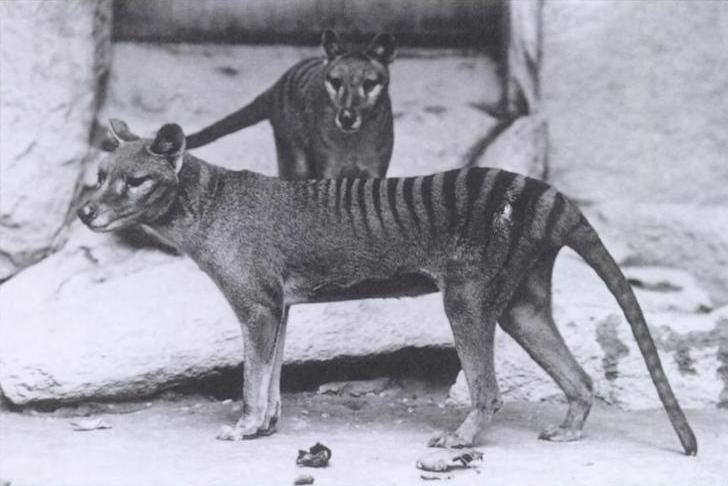Maybe Dingoes Don’t Deserve Their Bad Rap
Studies show that Australia’s “favorite scapegoat” most likely didn’t kill the Tasmanian tiger
/https://tf-cmsv2-smithsonianmag-media.s3.amazonaws.com/filer/7d/3e/7d3e390f-2e29-414c-9a87-7c43b496ef7f/dingo_on_the_road.jpg)
Dingoes are Australian icons for all the wrong reasons. Maligned as baby snatchers and sheep killers, the outback’s free-ranging dogs are viewed by many as pests. Until recently, they have also taken the blame for the extinction of two of the Australian mainland’s former inhabitants: the Tasmanian tiger and its relative, the Tasmanian devil.
Bert Roberts, a field ecologist at the University of Wollongong in Australia, argues for “a pardon for the dingo” in last week’s issue of Science and points to recent evidence placing the blame for those extinctions squarely on humans, instead.
For thousands of years, the Tasmanian tiger (Thylacinus cynocephalus), a wolf-like marsupial with tiger-esque stripes, dominated mainland Australia’s food chain, along with the Tasmanian devil (Sarcophilus harrisii). Hitching a ride with humans from Asia, the wild dogs showed up about 4600 years ago, and tigers and devils disappeared from the Australian mainland roughly 2000 years ago, persisting in their namesake, Tasmania. In 1936, the last Tasmanian tiger or "thylacine" died in captivity, and devils are near extinction now as well, thanks to human hunting and a contagious cancer.

Dingoes never made it to Tasmania, so people thought they must have out-competed and even eaten the native species for food on the Australian mainland. “It’s easy to see why, intuitively, the dingo was blamed for pushing the thylacine and devil over the brink on the mainland—a new large carnivore arrives in Australia, so surely things must have changed for the worse?” says Roberts.
But that thinking, Roberts points out, is flawed. He cites an Ecology study published in September, where researchers at the University of Adelaide mathematically modeled three potential extinction drivers for the Tasmanian tiger and Tasmanian devil: humans (hunting or competing for food), climate change, and dingoes. Factoring in things like predation rates and predator and prey populations, the scientists simulated several ways extinction might have gone down, involving none, some, or all of the drivers at play.
“The answer was surprisingly clear,” says Tom Prowse, an ecologist and a co-author on the study. Human population growth most likely drove the thylacines to extinction by competing with them for food. A drier climate may have also contributed to the species' decline. The other factors just weren’t as important, and dingoes actually had the smallest impact.
Models can never tell us exactly what happened, but they can point to the most plausible version of history, explains Prowse. Humans started settling Australia about 50,000 years ago and have already been implicated in the extinction of at least 20 “mega-mammal” species – giant wombats, platypus species, and oversized echidnas—within 10,000 years. But Australian mammals clearly still felt the effects of humans in much more recent prehistory. Untangling the breakdown of human impact versus climate change in these earlier extinctions has been hard, so their modeling approach “gives scientists a new tool in the shed to go and dig for clues,” says Roberts.
Despite their exoneration, dingoes still face a hostile relationship with humans. Early European settlers hated dingoes so much that in the 1880s they built a 3,488-mile-long fence across southern Australia to keep the wild dogs out of rangeland, where farmers grazed their cattle and sheep. Even today, dingoes are often shot or poisoned on both sides of the fence.
“Our study should help demonstrate that dingoes should not be viewed as dangerous threats to wildlife but as an important component of the contemporary Australian ecosystem,” says Prowse.
Dingoes and other top carnivores provide invaluable stability to ecosystems, according to another study in Science last week. Dingoes keep herbivores (such as rabbits and kangaroos) and smaller predators (like red foxes) in check, maintaining healthy populations of plants and smaller animals. The dingo fence actually created a natural field experiment, and scientists link some marsupial and rodent extinctions to the absence of dingoes.
Ironically, thylacines also suffered unjust persecution from European settlers, who hardly knew what to make of the bizarre marsupial tiger-dogs. Every so often reports surface of thylacine sightings in remote Tasmania. “Although history tells us that species can be wrongly classified as extinct,” says Prowse. “I think that in all probability we have lost the thylacine forever.”
As for the dingo, some scientists think that rampant crossbreeding between dingoes and domestic dogs will lead to the disappearance of pure dingoes within the next century. Pardoning the dingo—which the IUCN Red List now classifies as "vulnerable—might prevent it, too, from going extinct.
/https://tf-cmsv2-smithsonianmag-media.s3.amazonaws.com/accounts/headshot/Screen_Shot_2014-01-27_at_12.05.16_PM.png)
/https://tf-cmsv2-smithsonianmag-media.s3.amazonaws.com/accounts/headshot/Screen_Shot_2014-01-27_at_12.05.16_PM.png)